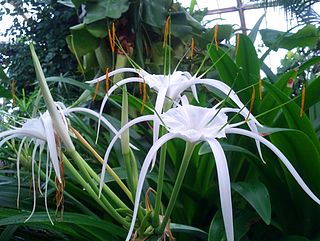
Abutilon is a large genus of flowering plants in the mallow family, Malvaceae. It is distributed throughout the tropics and subtropics of the Americas, Africa, Asia, and Australia. General common names include Indian mallow and velvetleaf; ornamental varieties may be known as room maple, parlor maple, or flowering maple. The genus name is an 18th-century New Latin word that came from the Arabic ’abū-ṭīlūn, the name given by Avicenna to this or a similar genus.

Disocactus is a genus of epiphytic cacti in the tribe Hylocereeae found in Central America, the Caribbean and northern South America. It should not be confused with Discocactus, which is a different genus.

Guarea is a genus of evergreen trees in the family Meliaceae, native to tropical Africa and Central and South America. They are large trees 20–45 m tall, with a trunk over 1 m diameter, often buttressed at the base. The leaves are pinnate, with 4–6 pairs of leaflets, the terminal leaflet present. The flowers are produced in loose inflorescences, each flower small, with 4–5 yellowish petals. The fruit is a four or five-valved capsule, containing several seeds, each surrounded by a yellow-orange fleshy aril; the seeds are dispersed by hornbills and monkeys which eat the aril.

Erythroxylum (Erythroxylon) is a genus of tropical flowering plants in the family Erythroxylaceae. Many of the approximately 200 species contain the drug cocaine; Erythroxylum coca, a native of South America, is the main commercial source of cocaine and of the mild stimulant coca tea. Another species, Erythroxylum vaccinifolium is used as an aphrodisiac in Brazilian drinks and herbal medicine.

Hymenocallis (US) or (UK) is a genus of American plants in the amaryllis family.

Melhania is a genus of small shrubs or herbaceous plants. Traditionally included in the family Sterculiaceae, it is included in the expanded Malvaceae in the APG and most subsequent systematics. The genus is named for Mount Melhan in Yemen.

Blakea is a genus of flowering plants in the family Melastomataceae. There are about 189 species distributed from Mexico to Bolivia and the Antilles. They are climbers, shrubs, and trees, some epiphytic.

Hibisceae is a tribe of flowering plants in the mallow family Malvaceae, subfamily Malvoideae.

Hernandia is a genus of flowering plants in the family Hernandiaceae. It was named after the Spanish botanist Francisco Hernández de Toledo.

Hermannia is a genus of flowering plants in the mallow family, Malvaceae. It comprises at least 65 species with many more species as yet unresolved.

Amphipterygium is a small genus in the subfamily Anacardioideae of the cashew and sumac family Anacardiaceae.
Humbertiella is a genus of plants in the mallow family, Malvaceae. The genus was named in 1926 for Jean-Henri Humbert (1887–1967), a French botanist and conservationist.

Cienfuegosia is a genus of plants, in the family Malvaceae and placed in the tribe Gossypieae. Species can be found in central and south America, Africa including the Arabian peninsula.
Bastardiastrum is a genus of flowering plants in the mallow family Malvaceae and is native to Mexico. They are shrubs or subshrubs with viscid stems.

Pagamea is a genus of flowering plants in the family Rubiaceae, native to northern South America. Shrubs or small trees, they are specialists in the Amazonian white-sand forests.
Andringitra is a genus of flowering plants belonging to the family Malvaceae.
Tarasa is a genus of flowering plants belonging to the family Malvaceae.












